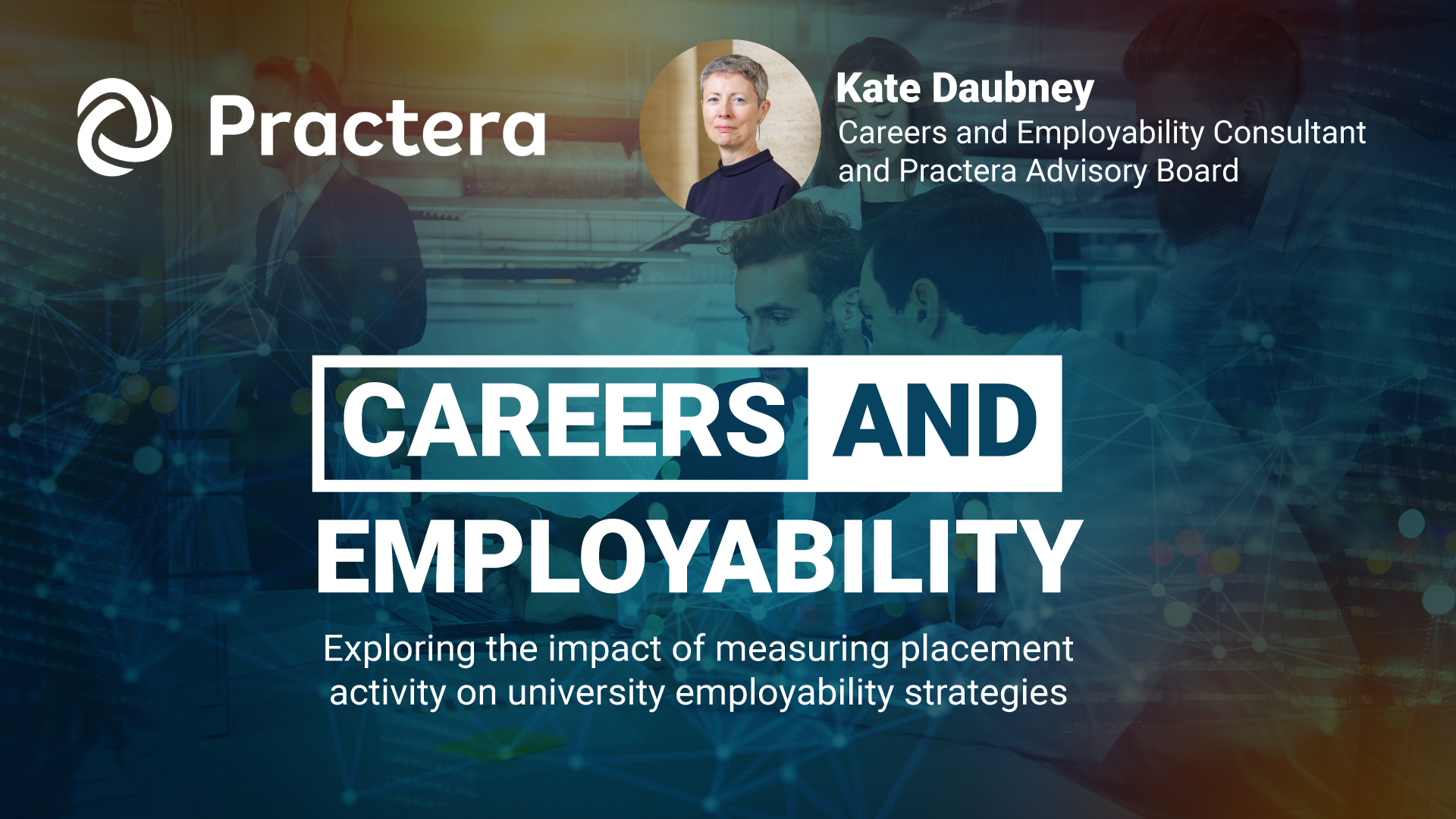Will the cart be leading the horse?
Exploring the impact of measuring placement activity on university employability strategies:
The emphasis on OffVenueActivity (OVA) in the UK’s Higher Education Statistics Agency’s Data Futures model indicates a shift in focus on the role played by in-curriculum placements and other work-related activity that takes place away from campus. HESA’s reason for requiring a return from higher education institutions on OVA is defined as:
To enable analysis of the delivery of placements or activity abroad; to enable analysis of student mobility and placements; to monitor how this activity impacts on student attainment and graduate outcomes; to monitor the characteristics of students undertaking this activity.
What makes an impactful work-related activity?
Arguably, the length of a trackable experience is a red herring. Clearly from a data collection point of view, a proliferation of very short work placements would be a nightmare to gather. But the implication of the OVA model is that that an experience has to be of 5 days in length (or 35 hours) to be impactful on students’ employability development. So what happens in that 5 days that makes it impactful?
Let’s imagine a hypothetical scenario where every undergraduate Finance course in the UK has an arrangement with every banking institution with UK offices to send their second year students onto a 5 day Spring Week or insight programme. These are often well-conceived programmes, but they are designed with the intention to engage future applicants and employees to join the sector and those organisations. For a second year Finance student who knows they want to work in the finance sector this is likely to be a very impactful activity. But for a student who enjoys their programme but doesn’t want to work in the sector, it’s not impactful in the same way but we would still be tracking it as if it were.
We might find that such a student is able to firm up their career plans in a very different direction as a result of this work-related activity, or we might find that it completely puts them off the sector and, perhaps, their programme too. So the stage of the student’s career readiness – their career planning – is a key factor in whether a work-related activity is impactful towards their graduate outcome. And we are also left with the question of whether tracking analysis will imply that a graduate outcome that is professionally aligned with its preceding placement is ‘good’, and possibly better than an outcome which is not professionally aligned with that placement.
By extension there is also a question about what is actually gained during the work-related activity. Exposure to large amounts of sector knowledge can often contribute very positively to a student’s career readiness and their ability to apply successfully for a role in that sector later on. But unless the student is also engaged in active skill development that is scaffolded with reflective learning on both that skill development and their knowledge gain, their ability to be successful in that role or sector is not being developed holistically, and the activity may not have as much impact as we might think.
If we are focused on sector knowledge gain, it would be easy for someone uninformed to argue that a student who takes part in a 25 hour small group collaborative employer project allocated at random has far less chance of developing their employability towards successful graduate attainment (and we aren’t tracking it anyway as it’s too short). But if that project is intentionally focused on five or six areas of skill development with strongly scaffolded reflective learning around it, I would argue that the gain to the student’s employability development is actually considerable, targeted and significant, even if it doesn’t move their ideas about their career plans further along and it doesn’t meet the definition of a trackable activity.
What it does do is impact the student’s ability to know what they can do and how to apply it, and that is a key element of successful entry to the workplace. Indeed, the Institute of Student Employers annual development surveys reinforce the importance of such self-awareness every single year. I’m not arguing for tracking shorter experiences, but I am saying that we need to think much more carefully about what makes an experience meaningful and impactful. Which leads us to this question:
What do we make of “need not be credit-bearing or linked to any learning outcomes”?
Researchers and practitioners including Aranee Manoharan (2020) have established the critical importance to an inclusive student learning experience of situating employability development in curriculum, and in many respects we might see OVA as evidence that this is being taken seriously. However, a work-related activity that is not credit-bearing is at risk of not realising the benefit for the student that it could.
It is completely reasonable that students with limited time due to other ‘real world’ commitments such as part-time employment and caring responsibilities will focus principally on assessed aspects of a course in order simply to achieve as well as they can. So, faced with a work-related project that is useful but not assessment critical because it has no learning outcome attached, those students can’t be blamed if they choose to step lightly through that experience in order to use their limited time to do better in an exam or other assessed piece of work that is tied to learning outcomes.
On the one hand, therefore, we might see HESA’s tracking of any experience of 5 days or more, regardless of whether it has a learning outcome or assessment attached, as very inclusive of all the different work-related activities that might take place within curriculum (see also Mark Peace’s inspiring article on Substack on all learning being experiential) and thus as inclusive as possible of all students.
On the other hand, if we are using the data collected to analyse the impact on those same students’ graduate employment, we are making some implied judgement calls about whether a student made the most of the experience they had in curriculum. In doing so, we are in danger of making some very risky and damaging assumptions not just about the impact on their graduate employment but also about whether the student was genuinely able to realise the benefit of the opportunity.
Will tracking OVA become a stick or a carrot?
Assessment in work-based learning should be formative and summative, providing students with constructive feedback. This continuous evaluation aids skill development and fosters a deeper connection between academia and industry.
All of the above has some really interesting implications for universities’ strategies to deliver education, careers education and employability. UK higher education institutions have focused increasingly on the integration of placements and experiential learning in curriculum in recent years, and sometimes these objectives can have quite a negative impact on academics’ perceptions of the relationship between academic curriculum and employability development (Daubney, 2022), particularly if they feel that curriculum integrity is being sacrificed. Integrating work-related learning is also a huge commitment of time and resourcing to design and deliver whether done internally or in partnership with a supplier.
But I can’t help but think that HESA’s decision to increase the tracking of work-related and experiential learning in curriculum is likely to show up later on in how the regulator evaluates what universities are doing to support graduate employment outcomes. And that before long this tracking will become another stick, rather than a carrot, when it comes to creating and delivering education strategies in universities.
Every institution will start thinking that they need to increase their work-related learning – at trackable levels – in order to meet that expectation. So my fear is that universities might look for easy routes to “tick off’ what they might very quickly come to see as an OVA ‘requirement’ to develop student employability in a particular way and in doing so also “tick off’ their academic staff, instead of thinking about more sustainable approaches to re-imagining existing curriculum that don’t require tracking but still develop student employability.
So, what does make an impactful work-related activity that benefits graduate outcomes that is worth building an education strategy around? HESA have put some criteria in place by explicitly stating ‘off venue’ as part of the definition, and in my capacity as an Advisory Board Member for experiential learning provider Practera, I clarified with HESA recently that ‘off venue’ does include virtual work experiences (my thanks to the HESA Liaison team for this). Either way, an employer is involved, and experiences like that can be very productively co-created either directly with employers or with suppliers of pedagogically sound experiential learning experiences.
But if you are an institution who hasn’t got the financial and staffing resource to reinvent your education strategy in that way, what do you do? Well, what if – instead of a Spring Week type experience – an academic created a piece of authentic (or more varied means of) assessment where each learning outcome also intentionally developed a different transferable skill and didn’t only assess knowledge gain?
Given that these transferable skills are the same ones that employers are looking for, could we not just as reasonably say that this is work-related and has an impact on graduate employability and employment? A student who can, for example, articulate how they have developed their ability to define a problem, or construct a narrative from evidence, or apply a model in different contexts and has some interesting ways to demonstrate that through assessment is going to be able to talk confidently about how their degree has helped them prepare for a range of different workplaces, and demonstrate that self-awareness that employers are looking for. And that is going to have a positive effect on their ability to secure a good graduate outcome.
But we aren’t tracking approaches like that, because we aren’t working with a new data collection model that even asks us to think about using learning outcomes to help students develop their transferable skills and thus get more impact from their education in their chosen graduate employment outcome. I hope therefore that universities, particularly those without the resource to commit to creating work-related activities in curriculum, will not feel panicked by the OVA, and will instead remember that they already have everything they need in their existing curriculum to make a positive impact on students’ future employability.
Kate Daubney
Careers and Employability Consultant and Practera Advisory Board
Kate Daubney is a former academic and a former head of university careers services, and now acts as a consultant on education, careers education and employability strategies to universities in the UK and internationally. She is an Advisory Board Member for Practera and on the Board of Gyrfa Cymru Careers Wales.
References:
Manoharan, A., (2020). “Bridging inclusion and employability: creating significant real-world experiences in the curriculum” in Baughan, P. (ed) Assessment and Feedback in a Post-Pandemic Era: A Time for Learning and Inclusion, (Advance HE) pp.118-126.
Daubney, K. (2022), ““Teaching employability is not my job!”: redefining embedded employability from within the higher education curriculum”, Higher Education, Skills and Work-Based Learning, Vol. 12 No. 1, pp. 92-106.




